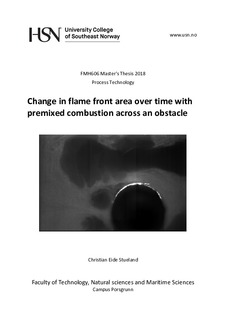Change in flame front area over time with premixed combustion across an obstacle
Master thesis
Permanent lenke
http://hdl.handle.net/11250/2567345Utgivelsesdato
2018Metadata
Vis full innførselSamlinger
Sammendrag
This thesis is a joint project of USN, and CMR Gexcon to explore the changes in flame front
area over time with premixed combustion across an obstacle. The objective of this thesis is to
make a literature review on relevant topics, as well as perform experiments with flame
tomography in the lab at USN. Through these experiments, this thesis will assess the change in
flame front area over time across an obstacle and explore whether there is any relation between
the different concentrations in H2-Air mixture. The method used to achieve this is performing
experiments with flame tomography and recording it with a high-speed camera. The experiments
are then evaluated through a MATLAB code developed during this thesis to track the flame front
area, and through this code provide three different results. First being the area of the flame front,
second being the change in area scaled to the cross-section area of the combustion chamber. The
3rd result being the change in area scaled to the cross section of the combustion area as well as
the laminar burning velocity, and relative density between burnt, and unburnt mixture at the
given H2-Air mixture. And all these are plotted dependent on the position of the flame front
relative to the position of the flame front. Through these experiments it has been found that
regardless of the concentration of the H2-Air mixture, the area of the flame front increases at a
consistent rate dependent on the flame front position. The change to flame front area scaled to
the cross-section area of the combustion chamber also stays consistent dependent on the flame
front position regardless of H2-Air mixture. When additionally scaled to the laminar burning
velocity, and relative density between burnt, and unburnt mixture, the results are no longer
consistent, with there being a decreasing value in change per meter with an increase in consentration.
